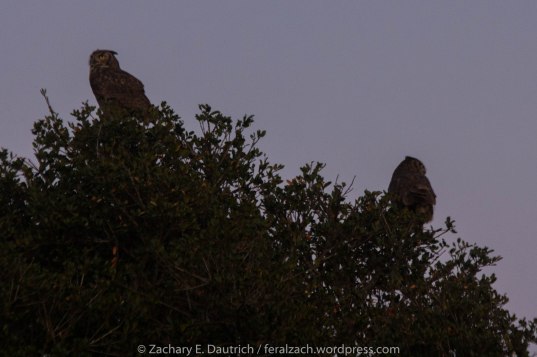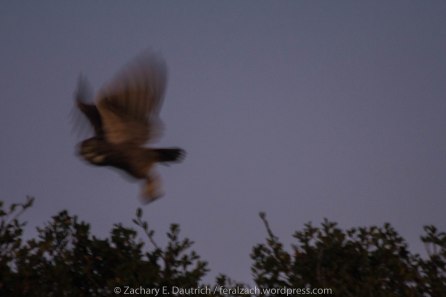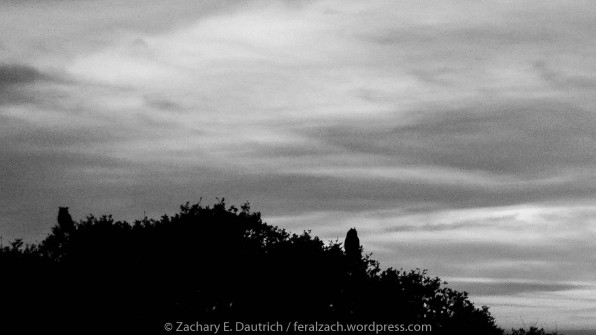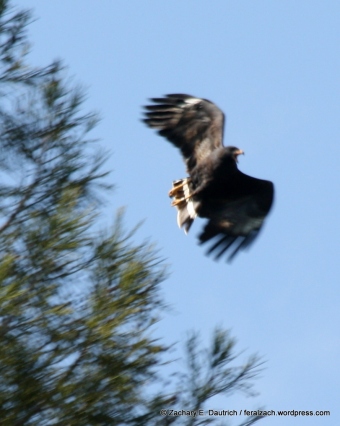2015 Feb 20 – owl voyeur (mating of the owls)
For the last two weeks, on at least six different nights, I’ve seen one of the pairs of owls who inhabit the area of my regular wanders mate. Owl love-making, owl coitus. Oh yeah.
I’ve gotten some decent audio recordings of it (wow, that sounds weird), but finally on Friday night I got a few photos (now it sounds even weirder). Owl voyeurism, what can I say. Happy they felt comfortable, and I take it as a sign that I’m doing a good job of making my presence unknown or, if they see me, not to put stress on the animals. I feel confident saying that they probably didn’t feel stressed.
It was past sunset, so the natural light was not so good, but it was really amazing to see, hear, and it left just enough light to photograph.
First, the female came out from her roost and was making vocalizations, presumably inviting the male in for some fun with that, um, sexy penetrating gaze?
After a few minutes, her seductive gaze shifted to a spot on the live-oak tree about 20 feet away where the male owl alighted …
The male perched on the other side of the same oak tree, surveying the surroundings (trying to look cool and non-nonchalant, I think).
Within a minute of the two being perched together on top of the tree, the male flew over and mounted the female to mate. Owls evidently aren’t so much into the foreplay stuff. Or, it’s indiscernible to human observers.
They sounded like a mixture between chimpanzees and some sort of song bird rapidly singing. It starts with a repetitive low “hoo hoo hoo” that sounds like a chimp or orangutang and quickly turns into a high frequency chirping sound. All in all in takes about 3 to 5 seconds. Fast and furious, a short but evidently fulfilling rendezvous. Not that you could tell by their reactions afterwards.
Afterwards, there was no cuddling. They both seemed pretty stand-offish, ready for breakfast …
Within a minute or so, the male flew off to start hunting for the night.
Hopefully I’ll see some owlets sometime soon.
2015 Feb 11 – venus and the owl
As I was returning from an evening wander, I rounded a corner and started ascending a ridge under a twilight sky that held a bit of vibrant dark blue that was stubbornly unyielding to the engulfing blackness of the night sky. As I looked up, I saw one of the owls perched with the planet Venus as a backdrop. I think they are getting used to me – it eventually let me pass by at a distance of no more than 10 to 15 feet as I continued on my way after snapping some pictures.
The picture below was from a few nights ago, they perch on top of these trees almost every evening after leaving their day roosts. They hoot and coo and squawk to each other there before going out to hunt, or sometimes just sit in silence together. And, at least during this past week, they have been mating there as well – something I’ve gotten to witness twice in the last few nights!
a black hawk in sonoma county – an inter-species love story
First off, let me say that I don’t count myself as a “birder” – not in the commonly understood definition of it, anyway. I’m not into checking boxes by a species and keeping track of my life bird count. Don’t get me wrong, I understand why people do it, and I’m happy they enjoy it. It’s just not me (so don’t call me a birder).
But I do love birds, and find myself drawn to them in particular among all my relations in the plant and animal world. For me, it is the interaction, the connection, with these other lifeforms that is the real juiciness. That is what drives my passion to be out in nature – genuine connection. Often that takes the form of simply witnessing … which in and of itself is extremely rewarding. Sometimes it’s not even seeing the animal, just its track & sign. But occasionally there’s an actual interaction, and when it happens – on the animal’s terms – it is magical. Sometimes too, it’s the story that accompanies a sighting that makes it memorable. It’s always about the story though, isn’t it?
So the appearance of a black hawk in Sonoma County – while certainly alluring to birders who get to check another box on their list – is of more interest than just that. It is also a unique love story.
Not only has a black hawk (normally native to texas, arizona, new mexico and points south) chosen to make its home here, it has taken a mate of another species (no, it’s not me) – a red-shoulder hawk!
I started watching the nest about a month ago after being notified of its whereabouts by some friends at West County Hawk Watch. It is located in a tall eucalyptus tree, and not easily viewed due to a lot of other trees around it (and private property). My first day there, they were brooding and I got to see two nest exchanges. Initially the black hawk was on the nest, then after a bit of time she started to make some vocalizations that reminded me of a kestrel. A few moments later, a red-shouldered hawk appeared in the air and flew to the nest, taking over incubation duties for enough time for the black hawk to stretch and do a little bit of preening. Then she was back on the nest – but not until she grabbed another few branches to add to it …
I’ve returned to the nest a number of times since, most recently on Sunday. It was a very hot day with temperatures in the upper 90’s (f), and when I arrived the black hawk was in the nest panting (black feathers are an interesting feature on a bird that typically lives in the hot dry desert?!). Once I set up a scope, my eye was treated to what I had been hoping to see – a fuzzy white head! There is at least one baby!
I had heard that this same couple, the black hawk and the red-shouldered hawk, had young last year. I felt lucky to get to see it with my own eyes. What will this little creature grow up to look like? Time will tell, and I hope to have updates soon as the little one grows and starts to get its first set of feathers.
I never saw the red-shoulder on Sunday, likely because I was there during the hottest part of the day when there is little animal activity (they are smarter than me, evidently). The pictures were digi-scoped, so they aren’t the best quality, but it allowed me to capture this exciting occasion.
Thanks to Larry Broderick and Yvonne Motherwell for sharing the location of the nest and supporting efforts to document and spend time witnessing these amazing animals.




















